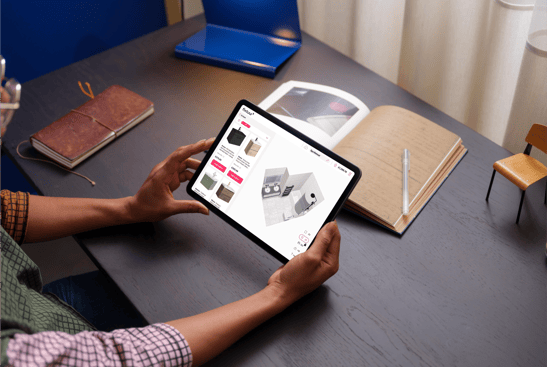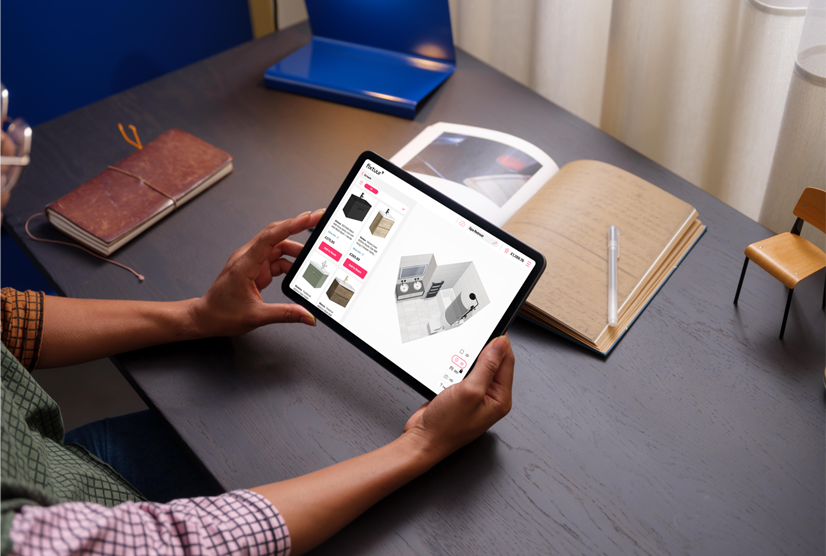Imagine asking a customer to visualise a sofa in their living room using just a flat photo. It’s like handing someone a jigsaw puzzle without the box lid! Ultimately, some will piece it together, but most won’t even try.
This is the problem 3D Room Planners solve.
Far from being just a nice-to-have digital extra, 3D room planners are fast becoming a core part of how retailers in furniture, homeware, and bathroom categories win sales, reduce returns, and create seamless ‘phygital’ shopping journeys. And the data backs it up.
What Is a 3D Room Planner?
A 3D room planner is an interactive tool that allows customers to design their space virtually by placing furniture, fixtures, and accessories into a digital replica of their own room layout.
![Fixtuur Bathroom Planner 2 [FA]](https://www.fixtuur.com/hs-fs/hubfs/Sales%20Email%20Images+GIFs%202025/Product%20GIFs/Bathroom%20Planner%20GIFs/Fixtuur%20Bathroom%20Planner%202%20%5BFA%5D.gif?width=640&height=476&name=Fixtuur%20Bathroom%20Planner%202%20%5BFA%5D.gif)
Unlike static images or mood boards, 3D planners offer a dynamic, immersive experience where consumers can try before they buy, without any cardboard cut-outs or tape measures.
These tools are often web-based and mobile-friendly (no downloads needed), and many can incorporate AR (Augmented Reality) views for even greater confidence.
The Commercial Benefits of 3D Room Planning
1. Confidence Converts: More Informed Shoppers Buy Faster
Consumers who use an online room planner are 3x more likely to convert than those who don’t, according to London Research's 2024 study. Why? Because they’re not guessing. They know the item fits, suits their space, and complements their existing style.
When shoppers can visualise how products work together, especially in sectors where size, finish, and layout are make-or-break factors, they gain the confidence to click ‘Buy Now’ instead of ‘Save for Later’.

2. Fewer Returns, Less Friction
Returns are the silent killer of eCommerce margins, especially in furniture and large-item retail. According to Shopify, return rates in home and furniture are around 10–16%, with many citing “it didn’t look right” or “didn’t fit” as the reason.
3D room planners drastically reduce this uncertainty. By allowing customers to experiment with layout and design before purchasing, retailers are seeing return rates drop by up to 30%. That’s not just better for the bottom line - it’s also a win for sustainability and customer experience.
3. Send to Store = Smarter Salespeople
Here’s where things get interesting. The best 3D room planner tools include a send-to-store feature, enabling shoppers to share their saved room designs with retail staff. This helps to turn showroom visits into personalized consultations.
Instead of walking in cold, customers arrive with a full brief: room dimensions, product preferences, style direction, and even saved product combinations. For store teams, it’s like being handed a pre-qualified lead with a ready-made quote!
That’s what we mean by phygital - the merging of physical and digital into one cohesive, customer-first experience.
Elevating the Experience Beyond Flat Images
Let’s face it: flat images are the brochureware of eCommerce! They might show off a product’s good side, but they don’t offer any interaction. They don’t show your space, your layout, or your style.
With a 3D room planner, the experience shifts from passive viewing to active exploration. Consumers become co-designers of their homes, not just buyers. It’s a psychological shift that changes how people engage with a brand, and it leads to longer session times, higher AOVs, and stronger brand loyalty.

3D Room Planners Aren’t Just for Shoppers. They’re Strategic Tools.
Think of the insights a room planner can generate:
-
Most commonly paired products;
-
Popular room layouts and sizes;
-
Colour and style preferences by region;
-
Drop-off points during the planning process.
This is gold dust for marketing, merchandising, and store planning. With the right analytics layer, your 3D room planner becomes more than a conversion tool! It becomes a source of first-party data, trend forecasting, and even inventory planning.
From Online Room Planner to Omnichannel Powerhouse
If your goal is to future-proof your retail experience, a 3D room planner is no longer optional - it’s foundational. Particularly for retailers selling bathrooms, kitchens, and furniture products for the whole home, room planners give consumers the tools to plan their purchases at the consideration moment when they are most likely to convert.
It’s the bridge between digital convenience and physical service. It’s the antidote to costly returns and abandoned baskets. And, increasingly, it’s the feature that separates brands doing ecommerce… from those doing it brilliantly.
TL;DR – The Business Case for a 3D Room Planner
Benefit |
Impact |
|---|---|
|
Increased Conversion |
+3x uplift vs static-only product pages |
|
Lower Return Rates |
Up to 30% reduction due to better visualisation |
|
In-Store Enablement |
Staff can access saved designs = faster close |
|
First-Party Data |
Product trends, layout preferences, shopper intent |
|
Customer Confidence |
Try-before-you-buy leads to fewer doubts and delays |
Ready to See the ROI for Yourself?
Speak to our team to model the sales lift, return savings, and in-store benefits of adding a 3D Room Planner to your site. It’s time to move beyond flat images and into full, immersive commerce!

